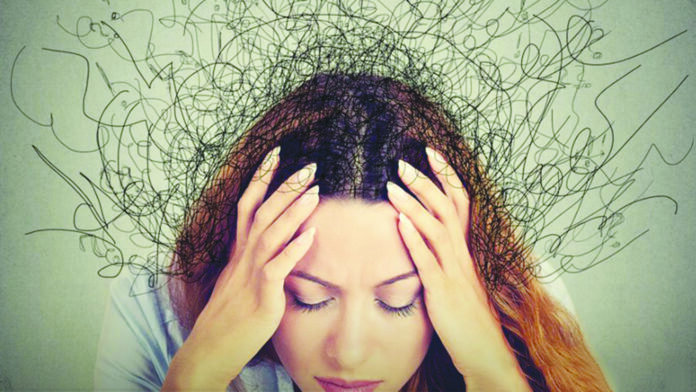Women’s mental health encompasses the emotional, psychological, and social well-being of women, shaped by a unique interplay of biological, psychological, social, and cultural factors.
A. BIOLOGICAL INFLUENCES: Women’s mental health is significantly influenced by biological factors, including genetic makeup, hormonal fluctuations, and reproductive health. Hormonal changes during menstruation, pregnancy, postpartum, and menopause can affect mood and behavior. Conditions such as premenstrual dysphoric disorder (PMDD), postpartum depression, and menopause-related mood swings illustrate the profound impact of hormonal changes on mental well-being.
B. PSYCHOLOGICAL DIMENSIONS: Psychological factors play a crucial role in shaping women’s mental health. Women may experience higher rates of certain mental health conditions, such as depression and anxiety, compared to men. Emotional regulation, coping strategies, and cognitive styles can differ between genders, influenced by both inherent and socialized factors.
C. SOCIAL AND CULTURAL CONTEXT: Social and cultural contexts significantly affect women’s mental health. Gender roles and societal expectations can create pressures that influence mental well-being. Women often juggle multiple roles, such as caregiving, professional responsibilities, and community involvement, leading to increased stress and potential mental health challenges. Social support systems, relationships, and community networks are vital for women’s mental health, providing emotional and practical support. In the context, intersectionality is a key concept in understanding women’s mental health, considering how overlapping identities such as race, class, sexuality, and age intersect to create unique experiences and challenges.
Recognizing intersectionality is essential for addressing disparities and promoting equity in mental health services. Access to quality mental health care is crucial for women’s well-being. This includes availability of counseling, psychotherapy, medication, and support groups. Culturally sensitive and gender-responsive approaches in mental health care can improve outcomes and support women in achieving better mental health. Women’s mental health is a multifaceted subject that requires a holistic understanding of biological, psychological, social, and cultural factors.
Women’s mental health is determined by a multitude of factors that can be categorized into biological, psychological, social, and cultural domains. Understanding these factors is essential for developing effective interventions and support systems.
A. PSYCHOLOGICAL FACTORS:
EMOTIONAL REGULATION: Women’s ability to regulate their emotions, influenced by both genetic and environmental factors, plays a crucial role in their mental health.
COGNITIVE STYLE: Negative thinking patterns, such as rumination or catastrophic thinking, can contribute to the development and persistence of mental health issues.
MENTAL HEALTH DISORDERS: Prevalence: Women are more likely to experience certain mental health disorders, such as depression, anxiety, and eating disorders. Understanding the symptoms and risk factors for these conditions is essential for prevention and treatment.
B. SOCIAL FACTORS:
FAMILY AND FRIENDS: Strong social support networks can provide emotional and practical support, which is vital for mental health.
INTIMATE RELATIONSHIPS: The quality of intimate relationships, including the presence of domestic violence or emotional abuse, significantly affects mental well-being.
ECONOMIC STABILITY: Financial stress and economic instability can lead to increased anxiety, depression, and other mental health issues.
ACCESS TO EDUCATION AND EMPLOYMENT: Opportunities for education and employment can impact self-esteem, financial independence, and mental health.
C. CULTURAL FACTORS:
CULTURAL NORMS: Societal expectations and cultural norms about gender roles can create pressure and stress, affecting women’s mental health.
MEDIA REPRESENTATION: Portrayals of women in the media can influence body image, self-esteem, and expectations, contributing to mental health issues like eating disorders and depression.
GENDER DISCRIMINATION: Experiences of discrimination and unequal treatment in various aspects of life can lead to stress, anxiety, and depression.
LIVING CONDITIONS: SAFETY: Living in a safe and supportive environment can enhance mental well-being, while unsafe or unstable living conditions can exacerbate stress and anxiety.
ACCESS TO HEALTHCARE: Availability of mental health services and general healthcare plays a critical role in the prevention and treatment of mental health disorders.
The differences between women and men in nature and mentality are shaped by a complex interplay of biological, psychological, social, cultural, evolutionary, and environmental factors. While there are general trends and tendencies, it is important to recognize the considerable overlap and individual variability within each gender. Understanding these differences can help foster a more inclusive and equitable society that appreciates and supports the diverse experiences and strengths of all individuals.
D. INDIVIDUAL FACTORS:
RESILIENCE: Traits like resilience and adaptability can help women cope with stress and adversity, mitigating the impact on mental health.
PERFECTIONISM: High levels of perfectionism can lead to stress, anxiety, and burnout, especially in environments that demand high performance.
E. COPING STRATEGIES:
HEALTHY COPING MECHANISMS: Effective coping strategies, such as mindfulness, exercise, and seeking social support, can protect mental health.
UNHEALTHY COPING MECHANISMS: Reliance on substances, denial, or avoidance can exacerbate mental health issues. Women’s mental health is influenced by a complex interplay of biological, psychological, social, cultural, environmental, and individual factors. Understanding and addressing these diverse factors is crucial for promoting mental well-being and ensuring that women have the resources and support they need to thrive.
Women and men differ in various aspects of nature and mentality due to a combination of biological, psychological, social, and cultural factors:
A. BIOLOGICAL DIFFERENCES:
GENETICS AND PHYSIOLOGY CHROMOSOMES: Women have two X chromosomes, while men have one X and one Y chromosome. These genetic differences influence the development of sex-specific characteristics.
HORMONES: Women primarily produce estrogen and progesterone, while men produce higher levels of testosterone. These hormones play significant roles in physical development, reproductive functions, and can influence behaviour and emotions.
BRAIN STRUCTURE AND FUNCTION:
NEUROANATOMY: Studies have shown some differences in brain structure between men and women. For instance, women typically have a larger corpus callosum, the part of the brain that facilitates communication between the two hemispheres. This could influence cognitive functions and multitasking abilities.
NEUROCHEMISTRY: Differences in neurotransmitter systems, such as serotonin and dopamine, can affect mood regulation and susceptibility to mental health disorders differently in men and women.
B. PSYCHOLOGICAL DIFFERENCES:
EMOTIONAL PROCESSING:
EMOTIONAL EXPRESSION: Women are often more expressive of their emotions and may have higher levels of empathy and emotional intelligence, though these tendencies can be influenced by socialization and cultural expectations.
STRESS RESPONSE: Women and men may respond to stress differently. Women are more likely to use social and emotional support systems, whereas men might adopt more problem-focused coping mechanisms.
C. EVOLUTIONARY PERSPECTIVES:
EVOLUTIONARY PSYCHOLOGY:
REPRODUCTIVE ROLES: Evolutionary theories suggest that different reproductive roles have shaped distinct psychological traits. For example, women’s roles in childbearing and nurturing may have led to greater empathy and social cohesion, while men’s roles in providing and protecting might have favoured traits like physical strength and risk-taking.
MATE SELECTION: Evolutionary pressures have also influenced differences in mate selection strategies, with women often prioritizing resources and stability and men prioritizing physical attractiveness and fertility.
The differences between women and men in nature and mentality are shaped by a complex interplay of biological, psychological, social, cultural, evolutionary, and environmental factors. While there are general trends and tendencies, it is important to recognize the considerable overlap and individual variability within each gender. Understanding these differences can help foster a more inclusive and equitable society that appreciates and supports the diverse experiences and strengths of all individuals.























